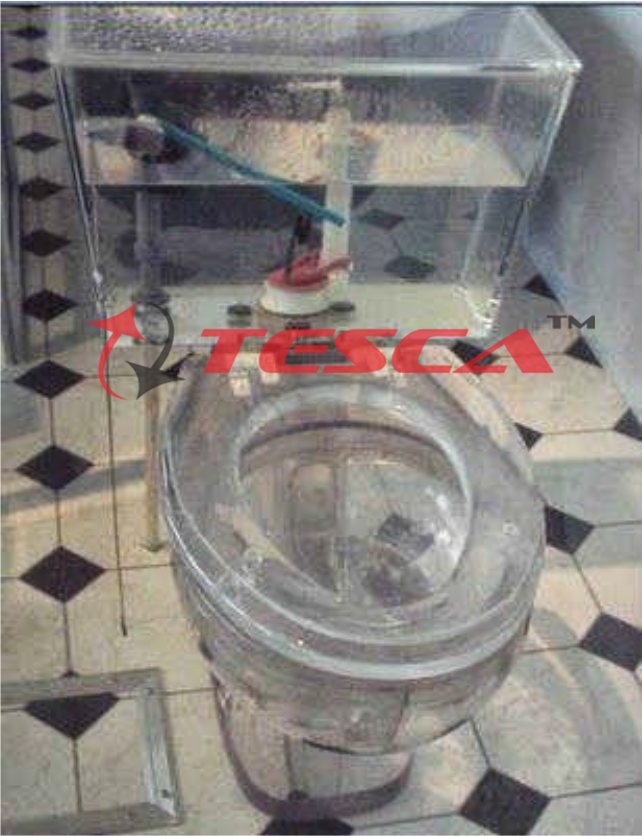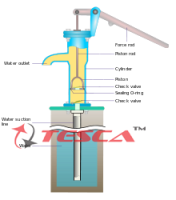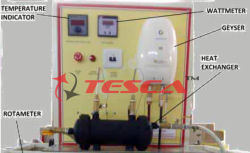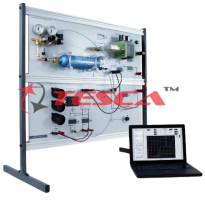Bathroom Apparatusliances Demo Panel

Order Code: 32502
Category: Other Trainers
Flushing the toilet opens the flush valve: A flush lever moves an arm to lift a flapper valve or tank ball to permit water to rush into the toilet bowl below, washing away waste into the sewer pipe. There are different type of ‘Flush...
SPECIFICATION
Flushing the toilet opens the flush valve: A flush lever moves an arm to lift a flapper valve or tank ball to permit water to rush into the toilet bowl below, washing away waste into the sewer pipe.
There are different type of ‘Flush Toilets’:
(A) Flapper valve controls toilet flush
When a gravity type toilet is flushed, the toilet flush valve sends water out of the toilet tank or cistern (conventional flush valves) or directly from the building water supply without a toilet tank or cistern (flushometer valves) into the toilet bowl below to flush waste into the building drain system. The two most common toilet flush valves used on toilets that make use of a tank or cistern are the flapper type toilet flush valve and the tank ball type toilet flush valve.
Flapper type is a toilet flush valve that closes the opening at the bottom of the toilet tank using a semi-round flapper (usually rubber) rather than the rounded tank ball. Like the toilet tank ball type flush valve the flapper valve is pulled up to open the toilet reservoir tank drain opening to send flush water down into the toilet.
There are many models of flush valves, using varying designs.
(B) A tank ball flush valve
Tank ball type flush valve: the control that sends water from the toilet tank (or building water supply) into the toilet bowl to flush away waste. There are many models of flush valves, using varying designs.
(C) Gravity flush toilet:
The conventional and most common water- operated toilet world-wide is flushed by water that flows (from a reservoir tank) into the toilet bowl by gravity; the reservoir tank must be above and is typically attached to or part of the toilet assembly.
At the end of the toilet flush, a ball cock valve or equivalent refills the toilet tank from the building cold water supply.
(D) Ball cock valve / Concentric Float Valve Type
The toilet ball cock fill valve shown in our photo at above left is a traditional side-float brass ball cock valve by Urrer is the control that refills the toilet tank after a flush. the rod that carries the float.
(E) Toilet Fill Valve Operation
The toilet fill valve admits water into the toilet reservoir tank or cistern to refill the cistern following a toilet flush. Most fill valve designs also send some water through the overflow tube and into the toilet bowl during cistern re-fill. Two common fill valve designs in current use are the ball-cock toilet fill valve and the concentric float toilet fill valve. Both of those designs are illustrated above.
Toilet Cistern / Tank Float-Controlled Fill Valve
The toilet tank float assembly activates the toilet fill valve as water level in the toilet tank or cistern drops during and at the end of a toilet flush.
Toilet Overflow Tube & Diverter Tube Type
Overflow tube, toilet: the overflow tube (photo above left), is found on virtually all modern toilet flush control valve assemblies.
This tube prevents a malfunctioning toilet tank refill assembly from flooding the building.
(F) Back Flush or Rear Flush Toilets Using a Reservoir Tank Type
A back-flush toilet that does use a reservoir tank is also produced for special situations such as a location that prohibits installing a drain line in the floor below the toilet. The plumber mounted a back-flush toilet on a short concrete pedestal, raising it just enough to flush into the nearby sewer line found in the wall behind the toilet.
(G) Up-Flush Toilets Located Below the Sewer Piping, No Toilet Tank Type
A variation on the flush valve toilet is the up- flush toilet used in bathrooms whose toilet was located below the building's sewer line exit to the sewer or septic system. An up-flush toilet relies on building water pressure to force the waste from the toilet up to a higher sewer line.
(H) Low Water Consumption Toilets - Water Saving Toilets Type
Water saving toilets use several strategies to reduce the volume of water used in flushing away waste: varying flush volume, pressure or power assisted flush using a small flush water volume, and reduced flush water volume using a reservoir barrier in th cistern or toilet tank.
(I) Air & Water Powered Flush Toilets (Pressure Assist)
These system traps air and as it fills with water, it uses the water supply line pressure to compress the trapped air inside. The compressed air is what forces the water into the bowl, so instead of the “pulling” or siphon action of a gravity unit, the pressure-assist unit “pushes” waste out
(J) Electric Flush Toilets & Pressure Assisted-Flush Toilets Type
Newer versions of the electric flush toilet made by Kohler include a reservoir tank and an electric pump that moves water from the reservoir through the bowl and toilet trap.
(K) Flushometer Toilets & Urinals Type
Tankless flush-o-meter valve toilets, in widespread use and unlike tank reservoir toilets, do not include a reservoir tank of water. The flushometer valve is particularly suitable to public restrooms since there is no delay between toilet uses waiting for a reservoir tank to refill. Typical flush volume is 1.6 gallons.











 91-9829132777
91-9829132777